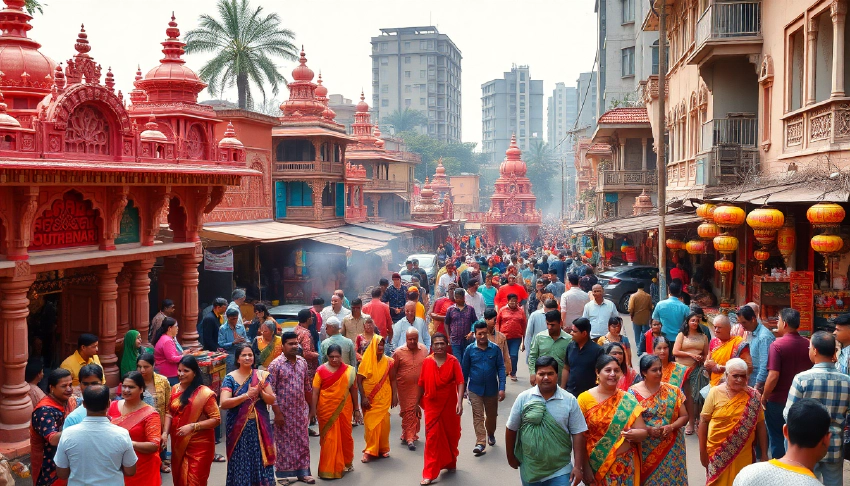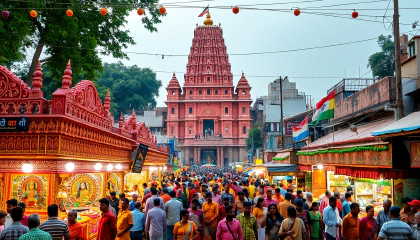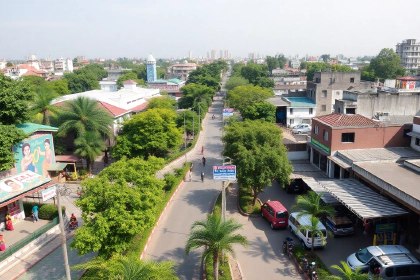
Chittaranjan Park: Delhi's Vibrant Bengali Cultural Hub
Exploring the Cultural Tapestry of Chittaranjan Park: A Journey Through Delhi’s Bengali Enclave
Introduction
Nestled in the heart of South Delhi, Chittaranjan Park (CR Park) stands as a vibrant testament to the resilience and cultural richness of the Bengali community in India’s capital. Originally established as a refuge for East Bengali migrants in the aftermath of Partition, this unique neighborhood has blossomed into a thriving hub of Bengali culture, seamlessly blending tradition with modern urban life. This article delves into the fascinating history, cultural significance, and evolving dynamics of CR Park, offering readers a comprehensive exploration of Delhi’s “Little Kolkata.”
The Historical Tapestry of CR Park
From EPDP Colony to Cultural Haven
CR Park’s journey began in the 1950s as the East Pakistan Displaced Persons (EPDP) Colony, a response to the urgent need for housing Bengali refugees. The transformation from a rocky, barren landscape to a well-organized residential area is a testament to the community’s determination and resilience.
Key Figures in CR Park’s Establishment
Visionaries like Chandra Kumar Mukherjee and Subodh Gopal Basumallik played pivotal roles in advocating for a dedicated Bengali enclave. Their efforts, supported by influential figures such as Chief Election Commissioner Shyamaprasanna Senverma, led to the allocation of land and the subsequent development of CR Park.
Evolution of the Neighborhood
Initially comprising about 2,000 plots across eleven blocks (A-K), CR Park has expanded over the decades to accommodate additional families. This growth has been accompanied by the establishment of essential institutions, markets, and cultural spaces, shaping the neighborhood’s unique character.
Cultural Landmarks and Community Spaces
Spiritual Centers
The Kali Mandir stands as a spiritual cornerstone of CR Park, hosting numerous religious activities and cultural events. This temple, along with others in the vicinity, serves as a focal point for community gatherings and celebrations, particularly during festivals like Durga Puja.
Educational Institutions
The Raisina Bengali School, established in the 1970s, plays a crucial role in preserving Bengali language and culture among the younger generation. Its emphasis on Bengali instruction alongside a standard curriculum underscores the community’s commitment to cultural preservation.
Markets and Culinary Delights
CR Park’s markets are a gastronomic paradise, offering an authentic taste of Bengal in Delhi. From fresh fish markets to shops selling traditional Bengali sweets and snacks, these bustling commercial areas are the lifeblood of the community, attracting food enthusiasts from across the city.
Cultural Organizations
Institutions like the Chittaranjan Park Bangiya Samaj and the Deshbandhu Chittaranjan Memorial Society serve as vital platforms for cultural expression and community engagement. These organizations host a variety of events, from literary gatherings to musical performances, keeping Bengali traditions alive in the heart of Delhi.
The Evolving Face of CR Park
Demographic Shifts and Urban Development
While CR Park remains a bastion of Bengali culture, it has also embraced diversity over the years. The influx of non-Bengali residents and the transformation of single-story houses into multi-storied apartments reflect the neighborhood’s adaptation to Delhi’s broader urban development trends.
Preservation of Cultural Identity
Despite these changes, CR Park has successfully maintained its distinct Bengali character. The vibrant celebration of festivals like Durga Puja, with its magnificent pandals and cultural programs, continues to be a hallmark of the area’s cultural calendar, drawing visitors from across Delhi and beyond.
Community Initiatives and Social Fabric
The strong sense of community in CR Park is evident in its numerous resident welfare associations and community-driven initiatives. From organizing cultural events to addressing local issues, these grassroots efforts play a crucial role in preserving the neighborhood’s unique identity and fostering social cohesion.
Case Study: Durga Puja in CR Park
Durga Puja in CR Park offers a vivid illustration of the neighborhood’s cultural vibrancy. Each year, the community comes together to organize elaborate celebrations across multiple venues. The festivities include:
- Intricately designed pandals (temporary structures) that often replicate famous architectural marvels
- Traditional dhunuchi dance performances
- Cultural programs featuring Bengali music, dance, and theater
- Food stalls offering a wide array of Bengali delicacies
This annual celebration not only reinforces cultural bonds within the Bengali community but also serves as a bridge to share their rich heritage with the broader Delhi population, exemplifying CR Park’s role as a cultural ambassador.
Conclusion
Chittaranjan Park stands as a shining example of cultural preservation and community resilience in the face of rapid urbanization. From its humble beginnings as a refugee settlement to its current status as a thriving cultural enclave, CR Park has maintained its Bengali essence while adapting to the evolving dynamics of Delhi’s urban landscape. As it continues to navigate the challenges of modern city life, CR Park remains a testament to the power of cultural identity and community spirit, offering valuable insights into the complexities of urban planning, cultural preservation, and social integration in India’s diverse capital city.





